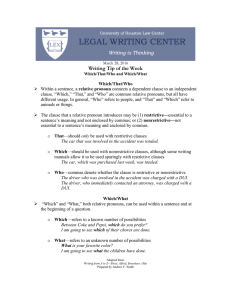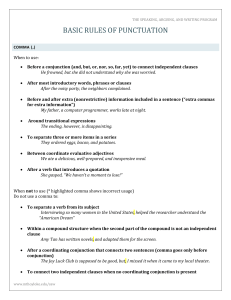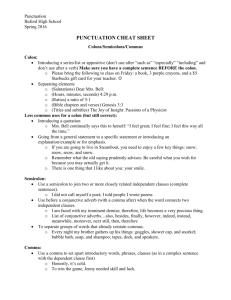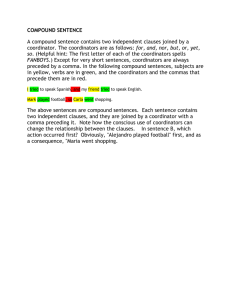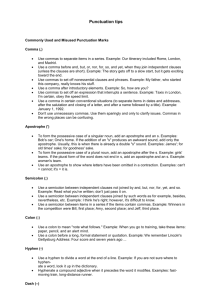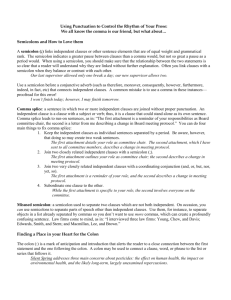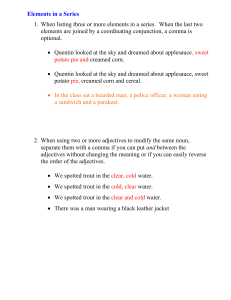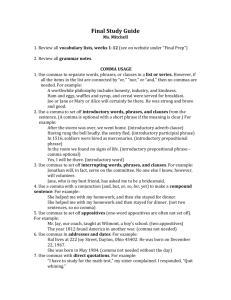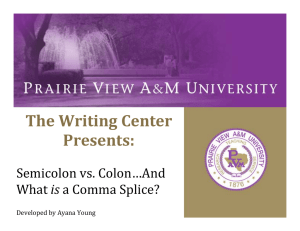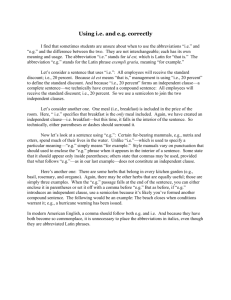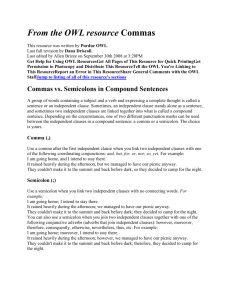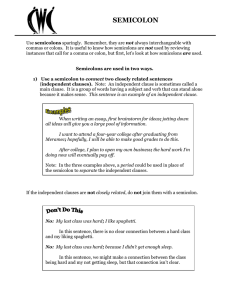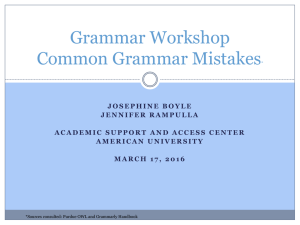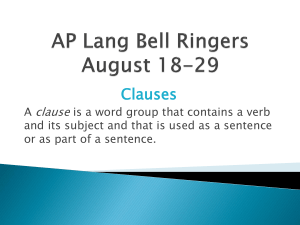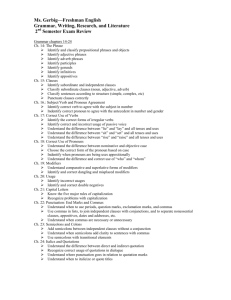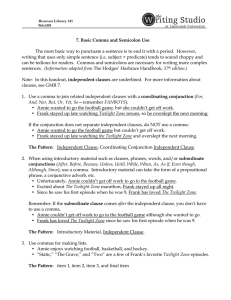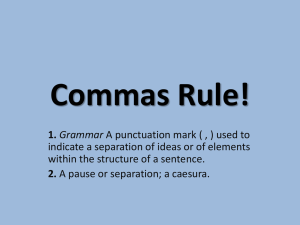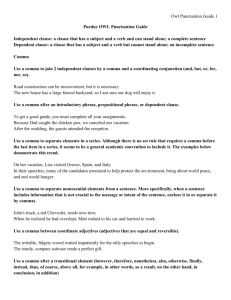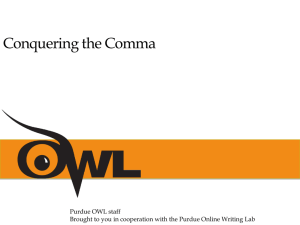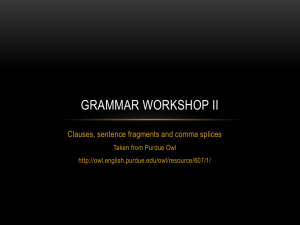Punctuation
advertisement
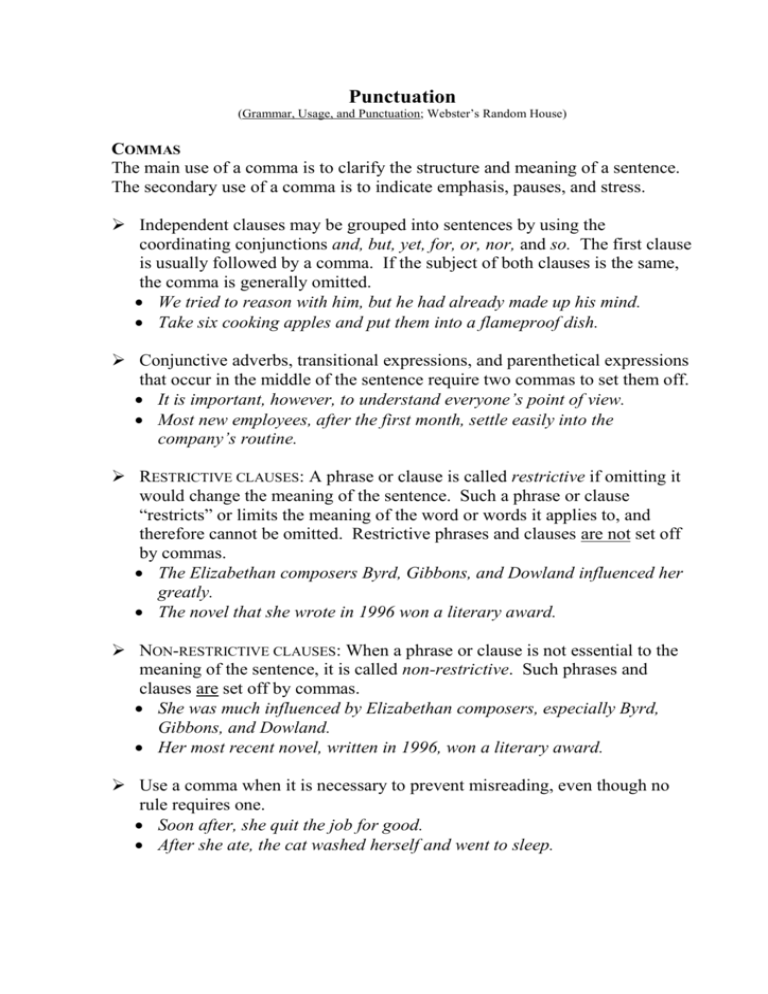
Punctuation (Grammar, Usage, and Punctuation; Webster’s Random House) COMMAS The main use of a comma is to clarify the structure and meaning of a sentence. The secondary use of a comma is to indicate emphasis, pauses, and stress. Independent clauses may be grouped into sentences by using the coordinating conjunctions and, but, yet, for, or, nor, and so. The first clause is usually followed by a comma. If the subject of both clauses is the same, the comma is generally omitted. We tried to reason with him, but he had already made up his mind. Take six cooking apples and put them into a flameproof dish. Conjunctive adverbs, transitional expressions, and parenthetical expressions that occur in the middle of the sentence require two commas to set them off. It is important, however, to understand everyone’s point of view. Most new employees, after the first month, settle easily into the company’s routine. RESTRICTIVE CLAUSES: A phrase or clause is called restrictive if omitting it would change the meaning of the sentence. Such a phrase or clause “restricts” or limits the meaning of the word or words it applies to, and therefore cannot be omitted. Restrictive phrases and clauses are not set off by commas. The Elizabethan composers Byrd, Gibbons, and Dowland influenced her greatly. The novel that she wrote in 1996 won a literary award. NON-RESTRICTIVE CLAUSES: When a phrase or clause is not essential to the meaning of the sentence, it is called non-restrictive. Such phrases and clauses are set off by commas. She was much influenced by Elizabethan composers, especially Byrd, Gibbons, and Dowland. Her most recent novel, written in 1996, won a literary award. Use a comma when it is necessary to prevent misreading, even though no rule requires one. Soon after, she quit the job for good. After she ate, the cat washed herself and went to sleep. SEMICOLONS A semicolon is used to separate parts of a sentence—such as independent clauses, items in a series, and explanations or summaries—from the main clause. Separate independent clauses not joined by a coordinating conjunction are separated by a semicolon. The house burned down; it was the last shattering blow. We have made several attempts to reach you by telephone; not a single call has been returned. When separate independent clauses are joined by a conjunctive adverb such as however, nevertheless, otherwise, therefore, besides, hence, indeed, instead, nonetheless, still, then, or thus, a semicolon is used after the first clause. The funds are inadequate; therefore, the project will close down. Enrollments exceed all expectations; however, there is a teacher shortage. Separate long or possibly ambiguous items in a series with a semicolon. In the next year, they plan to open stores in Sewickley, Pennsylvania; Belleville, Illinois; Breckenridge, Colorado; and Martinez, California. Academically talented students were selected on the basis of grades; tests of vocabulary, memory, reading, inductive reasoning, math, and perceptual speed and accuracy; and teacher recommendations. COLONS The colon tells the reader that the first statement is going to be explained by the second or that a quotation or series will follow. The cannot pay their monthly bills because their money is tied up in their stocks and bonds: they are paper-rich and cash-poor. There’s only one solution: we must reduce next year’s budget. Do not use a colon to introduce a list that is the object of the verb. The senior citizens’ demands included better police protection, more convenient medical facilities, and a new recreational center. Do not use a colon to introduce a list after the verb to be or following a preposition. The courses she is taking are French, medieval history, Greek, and the nineteenth-century novel. I have had enough of mosquitoes, leaking tents, wet blankets, and whining children. DASHES A dash is used to show sudden changes in thought or to set off certain sentence elements. Dashes are dramatic and thus should be used sparingly. He won the game—but I’m getting ahead of the story. She told me—does she really mean it?—that she will inform us of any changes in advance. PARENTHESES Parentheses are used to enclose nonessential material within a sentence. This can include facts, explanations, digressions, and examples that may be helpful but are not necessary for the sentence. Faulkner’s stories (but not his novels) were required reading for the course. The community didn’t feel (and why should they?) that there was adequate police protection. Parentheses are also used to enclose part of a sentence that would be confusing if enclosed by commas. The authors he advised (non other than Hemingway, Lewis, and Cather) would have been delighted to honor him today.

